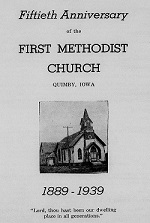
Click image to enlarge
|
HISTORY OF THE QUIMBY METHODIST EPISCOPAL CHURCH
From 1889-1939
The
Quimby M. E. Class was organized in March 1889 by Rev. J. L. Whitney,
pastor at Washta, who then continued to serve this charge until the end
of the conference year. The new church building was erected in 1889 and
dedicated on July 7th of that year.
However,
this was not the beginning of Methodist services, for almost from the
time the first buildings were erected in the town, services were held
in the upper room of what is now the Pinkerton Implement Building,
access to which was gained by means of a wooden stairway on the North
side, the outline of
which is plainly visible yet today.
This
early congregation was on a circuit with several other points and was
served by an itinerant preacher who made the rounds periodically. There
appears to be extant no complete list of the charter members of the
newly organized church but it seems that as to numbers there must have
been 45 or 50 among which stand out prominently such names as the
following:
A.
R. Hubbard and wife, Jonah Clark and wife, Philipp Cline and wife, F.
A. Barnes and wife, R. J. Thurber and wife, Miron Jenness and wife,
James Will and wife, H. E. Ashton and wife, Frank Dodd and wife, G. W.
Buck and wife, David Bulock, Jacob Lauer, Jessie Zupp, Clara Tolbert
and many others.
A friendly rivalry between the Methodists and
their sister church (the United Presbyterians) whose building was also
in process of construction arose out of the Illinois Central Railroad's
offer to contribute a pulpit set to the one being the first to
dedicate. This was won by the Methodists. The U. P.'s received a pulpit
Bible. Judged by the standards of today, the new church building was
small in size, simple in architecture, and totally lacking in modern
conveniences. But to the people of the day who werepredominantly poor
and accustomed to seeing small buildings, it no doubt appeared
collossal, a thing of beauty, and a joy forever. We can well imagine
with what feelings of pride, satisfaction, and thanksgiving those who
had taken upon themselves the responsibility of raising the funds, saw
their task completed.
Even
today it is no easy matter to raise funds for the building of a church.
Can we imagine what it must have been half a century ago when the
country was new, crops poor, prices low, grasshoppers prolific, with no
benificent government to furnish combatant aid, W. P. A. work, or
monetary relief; when every family must make its own way, provide for
itself or starve.
Reminiscing, Mother Hubbard remembers how she
and her husband spent whole days driving over this country with team
and buggy upon the discouraging task of soliciting monetary pledges for
the erection of a house of worship.
All
honor to those religious pioneers most of whom have now passed to their
reward, who so caught the vision and became so engrossed with their
task that they were willing to give until it hurt, cheerfully suffer
all rebuffs, and utterly refuse to succumb to discouragement, that they
and their neighbors might have a house in which to worship and that
theirs and their neighbors children might have an opportunity to learn
about God.
They were quick to realize that the forces of evil
were sure to be at work in this new community, that Satan would be on
the job to furnish plenty of that which would tend to degrade. There
would be no question about the activities of the "Powers of Darkness."
They were determined that into this darkness there should shine one
beacon light although it be projected by only kerosene lamps but coming
from the windows of the House of God.
And so throughout the
years about the only moral light in this community has come from those
windows and the windows of the sister church and about the only things
that have been pointing Heavenward have been their steeples. In
this connection and to the credit of both groups may it be proudly said
that there was never any friction worth mentioning between the two and
when finally because of removals, the U. P.'s decided to discontinue
services, the Methodists bought their building united theirs to it, and
rededicated to God the whole as one unite on February 1, 1925, Rev.
Arthur Dyson then serving the charge. A number of the U. P. members
later united with the Methodist church and have proven to be a very
valuable asset.
The
Quimby M. E. Church has just cause to be proud of the array of splendid
Godly men who have filled her pulpit during the half century of her
existence.
Almost
without exception they have proved to be men of consecration,
fearlessness and exceptional ability, rightly dividing the Word of God,
rejoicing in the truth. Following is a complete list of pastors serving
the charge from the timeof organization up to and including the present:
J.
L. Whitney, S. H. Middlekauf, C. M. Phoenix, G. G. Yeoman, G. L.
Tennant, E. W. B. Tatlow, Thomas Carson, E. T. Fegtley, F. L. Moore, W.
L. Marsh, Alonzo Brown, J. P. Allen, E. J. Bristow, A. A. Pittenger,
Samuel Knor, J. C. Shirk, R. A. Harwood, A. L. Norfleet, E. J. Plummer,
J. V. Madison, W. E. Ellison, L. E. Wardle, J. L. Whitney, Freemont
Faul, J. H. Bound, Arthur Dyson, W. C. Bergman, J. S. Hutchings, Watson
Herrold, F. C. Pruel, H. W. Faris, O. E. Shaul, H. G. Dawes.
|